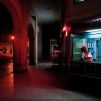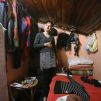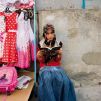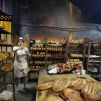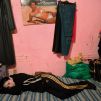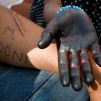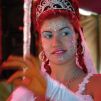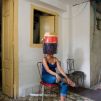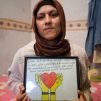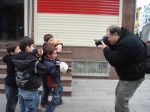CACT E-STUDIO
Giorgos Katsagelos was born in Arnea, Chalkidiki in 1957.
He studied at the Brooklyn College, NY. He lives and works in Thessaloniki.
Human Burdens - Vital Values
When I met Giorgios Katsagelos watched the way he works, I realized what a difficult and tiring procedure is the approach of a human being in his or her natural living conditions, whether it concerns a poor immigrant in a temporary lodging or a rich jeweler in his expensively decorated apartment, whether it concerns a young waitress in the restaurant where she works in Cuba or a painter in her atelier in Armenia. Giorgios Katsagelos is not interested in a hasty glance that will stealthily catch a remarkable snapshot. The final image is the result of a time consuming occupation with the model: he introduces himself, listens, talks and finally takes photos. And this is only the beginning because he will come back many times, he will detect with greater precision the relationship of the model with the environment and the other people, he will gain trust in order to be able to see in the objects and persons who surround the model his or her past and present, to record the movement of the body that indicates the dynamics of the future. He will finally select one picture among tens and hundreds: the one that will codify all the information in a final picture with the aspiration nothing to be superfluous and nothing to be missing.
The photos by Giorgios Katsagelos are human centered narrations that do not intend to beautify anything. This does not mean, however, that Beauty does not concern him. On the contrary: the Beauty is in the effort for survival, in the need of a young Muslim girl to read a book while she is trying to sell her merchandise, in the wish of an elderly immigrant woman to offer some coffee, in the fatigue after work, in the pride for one’s family, in the happiness of the rite, in the consolation when confronted with death, in the hope for the future. The search of the Beauty does not have as a pretext beautifying or decorative rules. Beauty is treated like one of the basic, high values that with others, like love, pain, justice, turns the questioning of the spectator to primal vital values that remind him or her that the complexity of our life has scorned ideologies and disused theories. We must now search for a new, primarily humanistic beginning, in order to understand the present and face the future.
In the series of women there is also beauty. How could it be otherwise? However, the women of the images by Giorgios Katsagelos have nothing to do with the stereotypes of beauty, that have been fixed in our conscience. Their clearly humanistic beauty originates from their own effort to get a grip of their lives and earn what they deserve in life. This is obvious in the photos, which are remarkably narrative. Each one of these women plays the leading role in a true story that could have been written next to the photo. It is, however, better that it has not been written. Otherwise, the story would have debilitated the spectator’s effort to decode the dense information, to identify the psychological tracking and to read the context in these portraits. Moreover, it is restrictive for the totality of the work to isolate each narration from the general story that was the spark for the creation of the series. Giorgios Katsagelos is led from the general to the specific. His route offers particular stories that, even though they are independent from each other, they are at the same time constituents of the main story. This route has no ending and I have the impression that this fact is one of the inmost concerns of the photographer. It is a procedure that is similar to the scientific investigation and interpretation method.
Women constitute a chapter of the different series on which Giorgios Katsagelos insistently builds his general topic that is the human being and the everyday life. Subchapters of the women are included in other series, like the series on child labor, the series on ethnic minorities in Istanbul or the series on religious worship. In his effort to exclude from the presentation of human striving elements of conscious or subconscious national character, he decides to distance himself from Greek reality. Only two of the published photos have been taken in Greece. Even these two are the outcome of a journey. The preparation of the journey and the new location keep the eye alert to images that could otherwise have been invisible due to habit and familiarity.
The photos by Giorgios Katsagelos are at the same time documents and works of art. They are documents, because of the existing knowledge and realization that photography has changed the method of historical approach by replacing and complementing verbal descriptions. They are works of art, due to the fact that they are psychological portraits that offer multiple reading layers by presenting the body language and by transmitting aesthetical messages concerning the structure of the image, the balance of the lines and the levels, the harmony of the colors.
Primarily, however, the photos by Giorgios Katsagelos are without any doubt humanistic.
